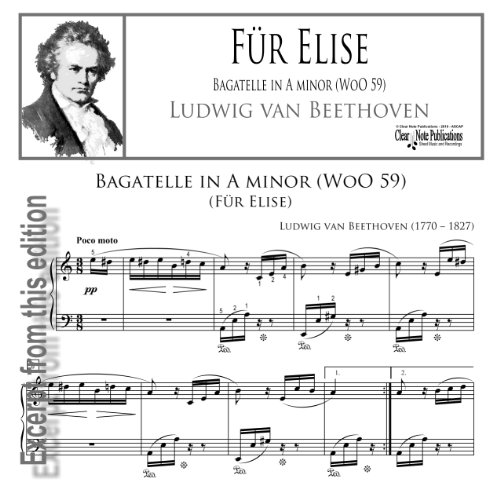Product Description
Bagatelle No. 25 in A minor (WoO 59 and Bia 515) for solo piano, commonly known as "Für Elise" (English: "For Elise"), is one of Ludwig van Beethoven's most popular compositions.
The piece is in A Minor and is set in 3/8 time. It begins with an A minor theme marked 'Poco moto' (with movement), with the left hand playing arpeggios alternating between A minor and E major. It then moves into a brief section based around C major and G major, before returning to the original theme. It. then enters a lighter section in the subdominant key, F major. It consists of a similar texture to the A section,where the right hand plays a melody over left hand arpeggios. It then enters a 32nd note C major figure before returning to the A section. The piece then moves to an agitated theme in D minor with an A pedal point, as the right hand plays diminished chords. This section then concludes with an ascending A minor arpeggio before beginning a chromatic descent over two octaves, and then returning to the A section. The piece ends in its starting key of A minor with an authentic cadence. Despite being called a bagatelle, the piece is in rondo form. The structure is A - B - A - C -A. The first theme is not technically difficult and is often taught alone as it provides a good basic exercise for piano pedalling technique. However, much greater technique is required for the B section as well as the rapid rising A minor figure in the C section.
Product Description
Bagatelle No. 25 in A minor (WoO 59 and Bia 515) for solo piano, commonly known as "Für Elise" (English: "For Elise"), is one of Ludwig van Beethoven's most popular compositions.
The piece is in A Minor and is set in 3/8 time. It begins with an A minor theme marked 'Poco moto' (with movement), with the left hand playing arpeggios alternating between A minor and E major. It then moves into a brief section based around C major and G major, before returning to the original theme. It. then enters a lighter section in the subdominant key, F major. It consists of a similar texture to the A section,where the right hand plays a melody over left hand arpeggios. It then enters a 32nd note C major figure before returning to the A section. The piece then moves to an agitated theme in D minor with an A pedal point, as the right hand plays diminished chords. This section then concludes with an ascending A minor arpeggio before beginning a chromatic descent over two octaves, and then returning to the A section. The piece ends in its starting key of A minor with an authentic cadence. Despite being called a bagatelle, the piece is in rondo form. The structure is A - B - A - C -A. The first theme is not technically difficult and is often taught alone as it provides a good basic exercise for piano pedalling technique. However, much greater technique is required for the B section as well as the rapid rising A minor figure in the C section.



